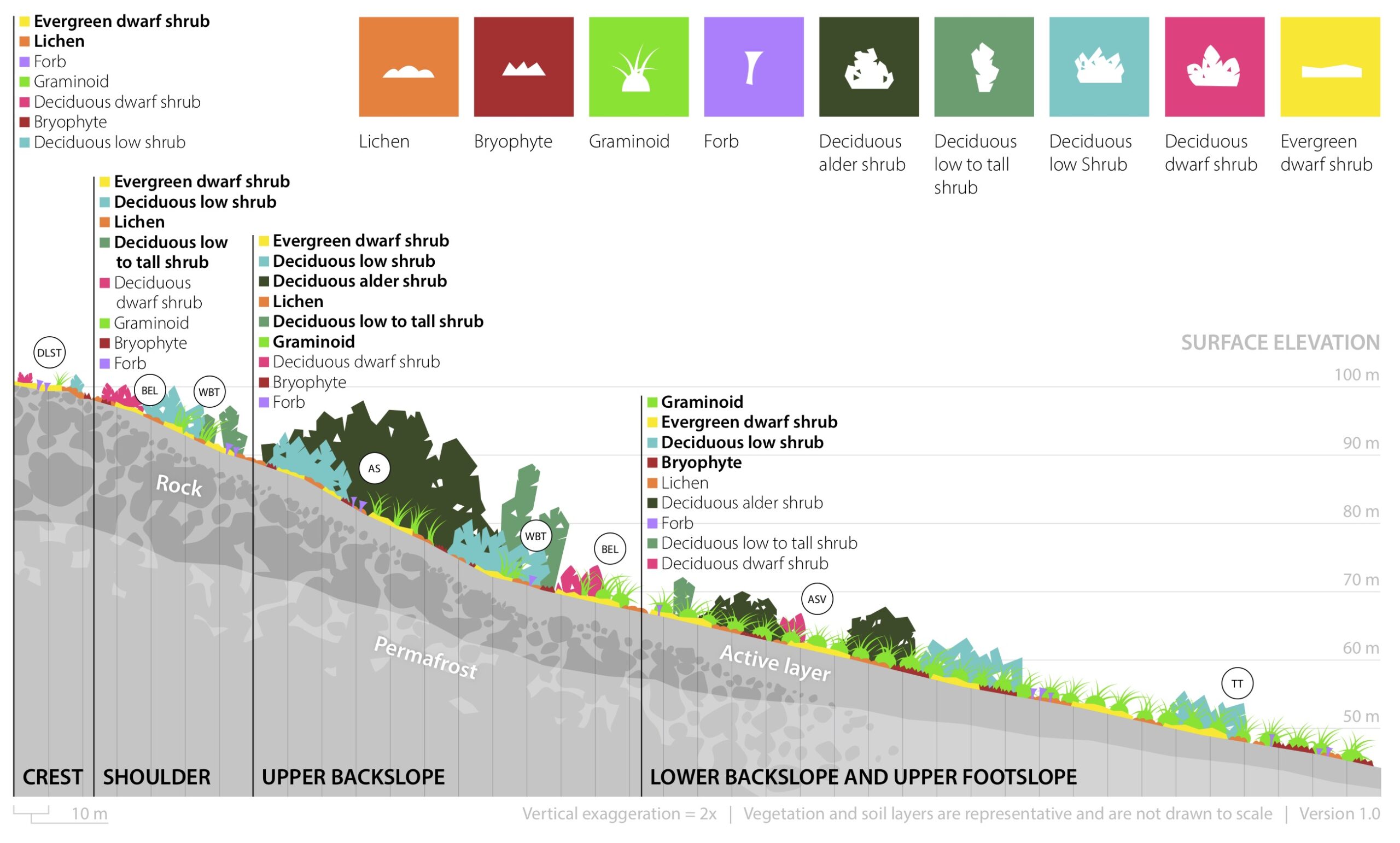April 16, 2021
Integrating Arctic Vegetation Types Into a Terrestrial Ecosystem Model Using Above- and Below-Ground Field Observations
Better representation of arctic plant communities allows more accurate model simulations of high-latitude carbon cycling

Toposequence figure of the Kougarok hillslope showing the distribution of plant functional types and communities along with underlying soil layers. Vegetation and soil depths not drawn to scale.
[Reprinted under a Creative Commons Attribution 4.0 International License (CC BY 4.0) from Sulman, B.N., et al. “Integrating Arctic Plant Functional Types in a Land Surface Model Using Above‐ and Belowground Field Observations.” Journal of Advances in Modeling Earth Systems 13(4), e2020MS002396 (2021). https://creativecommons.org/licenses/by/4.0/]
The Science
Arctic ecosystems are home to specialized plant communities that have adapted to cold winters and short growing seasons. Researchers used measurements of aboveground and belowground plant biomass across different plant communities in the Seward Peninsula of Alaska, USA, to add additional Arctic plant types to an ecosystem model. The new plant types allowed the model to simulate how ecosystems dominated by tall shrubs could gain biomass at much faster rates than ecosystems with thin soils and small plants.
The Impact
Model predictions of the Arctic carbon cycle are important for understanding future climate because the Arctic region contains vast amounts of carbon. Improved models that include more types of Arctic vegetation can simulate the different responses of various plant types and vegetation communities to warming and other environmental changes in high latitude ecosystems. These improvements will allow more accurate predictions of how carbon cycling in the Arctic will change in the future.
Summary
Accurate simulations of high latitude ecosystems are critical for confident Earth system model projections of carbon cycle feedbacks to global climate change. Many ecosystem models represent high-latitude vegetation, using only two plant functional types (PFTs) representing shrubs and grasses, thereby missing the diversity of Arctic vegetation growth patterns. This study used field observations of above- and belowground vegetation biomass and traits across a gradient of plant communities on the Seward Peninsula in northwest Alaska to incorporate nine Arctic-specific PFTs into an ecosystem model. The newly developed PFTs included: (1) mosses and lichens, (2) deciduous and evergreen shrubs of various height classes, including an alder shrub PFT, (3) graminoids, and (4) forbs. Improvements relative to the original model configuration included greater belowground biomass allocation, persistent fine roots and rhizomes of nonwoody plants, and better representation of variability in total plant biomass across sites with varying plant communities and depth to bedrock. Simulations through the year 2100 showed alder-dominated plant communities gaining more biomass and lichen-dominated communities gaining less biomass compared to original model PFTs. These results highlight how representing the diversity of Arctic vegetation and confronting models with measurements from varied plant communities improves the representation of Arctic vegetation in terrestrial ecosystem models.
Principal Investigator
Benjamin Sulman
Oak Ridge National Laboratory
[email protected]
Program Manager
Daniel Stover
U.S. Department of Energy, Biological and Environmental Research (SC-33)
Environmental System Science
[email protected]
Funding
This work was supported by the Next Generation Ecosystem Experiments (NGEE) Arctic project and by the Energy Exascale Earth System Model (E3SM) project, funded by the Office of Biological and Environmental Research (BER) in the U.S. Department of Energy’s (DOE) Office of Science.
Related Links
References
Sulman, B.N., et al. "Integrating Arctic Plant Functional Types in a Land Surface Model Using Above‐ and Belowground Field Observations." Journal of Advances in Modeling Earth Systems 13 (4), e2020MS002396 (2021). https://doi.org/10.1029/2020MS002396.

